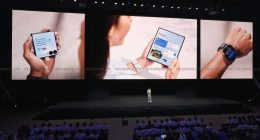Though Samsung did not have the best of times last year but it hasn’t been reflected in the yearly (as well as quarterly) figures as much. The Korean behemoth has today reported its fourth quarter earnings, which fall in line with the guidance figures published last month. But, the surprising feat of the said fourth quarter is that it has come out to be the most profitable for Samsung in over three years.
For the fourth quarter, the Korean giant has posted a consolidated revenue of 53.33 trillion won (approx $45.78 billion) on the back of 9.22 trillion won (approx $7.92 billion) in operating profits. This means that the profit jumped more than a 50 percent when compared to figures from the same period a year ago. The profits stood at about 6.14 trillion (approx $5.3 billion) won during the previous year.
The total capital expenditure (CAPEX) achieved by Samsung in the complete fiscal year 2016 stood at KRW 25.5 trillion, which is lower than the previous guideline of KRW 27 trillion. The company failed to achieve this figure but plans to carry forward the same over to 2017. As for individual figures, it invested KRW 9.8 trillion in the display business and KRW 13.2 trillion in the semiconductor arm.
These figures exceed analyst estimates, who expected the numbers to tank due to the explosive Galaxy Note 7 mishap. But the memory and display business have helped the company stay afloat in these tough times. The company also attributes the hefty rise in profit figures to the stronger US dollar against the Korean won. The same has been mentioned in the official statement as under:
Robust sales of high-end, high-performance memory products and expanded process migration in V-NAND, plus strong shipments of OLED and large-size UHD panels contributed to profitability.
The quarterly earnings have further been topped off with the earnings call for the complete fiscal year. Samsung has posted that its operating profit increased from 26.41 trillion won (approx $22.7 billion) to 29.24 trillion won (approx $25.12 billion) in this fiscal year. The full-year revenue figure for 2016 also rose from 200.65 trillion won (approx $172.42 billion) to 201.87 trillion won (approx $173.4 billion), which is great taking into account the events of last year.
Though the Korean giant suffered a mighty blow in the form of the explosive Note 7, which had to be completely recalled from the market. It still managed to perform significantly well in the lower-budget segment, where the Series A and J phones helped boost sales. The premium Galaxy S7/S7 Edge sales also helped Samsung deliver a year-over-year profit increase of over 4 percent to more than $2 billion. It would’ve already removed the significant chunk of resources and capital the unfortunate Note 7 explosion events has depleted.
Talking about the same, the official statement reads,
For 2016, Samsung achieved solid results despite the Note 7 discontinuation in the second half as a result of continuous efforts during past two to three years to strengthen its component business competitiveness by focusing on value-added products and widening the technology gap in the DRAM business as well as strategic investments in V-NAND and OLED.
The company just yesterday outed the results of its Galaxy Note 7 investigation and cited two major battery flaws, which caused the devices to catch fire and explode. Samsung has also laid out a fresh set of measures to check the batteries they’ll now be using in their devices. This memorable incident has depleted the brand image as well as consumer trust for Samsung. And it now plans to gain the same back with its upcoming flagship release — Galaxy S8.
Further, Samsung has reported that the overall earnings for the first quarter of this fiscal year are expected to decline QoQ. This will be the case due to “increased marketing expenses in the Mobile business and a sales decrease of TVs due to weak seasonal demand.” The Korean giant, however, expects the chip business to achieve solid figures even after a slowdown in sales. The phone maker now plans to expedite to expedite its efforts for making high-density and high-performance products.





